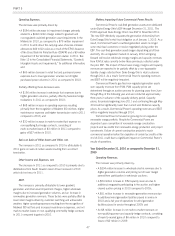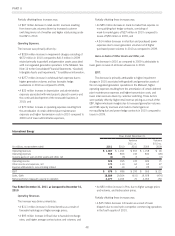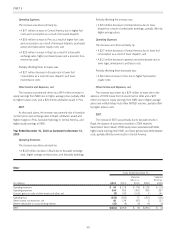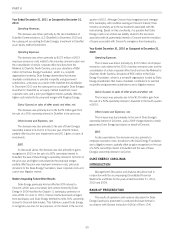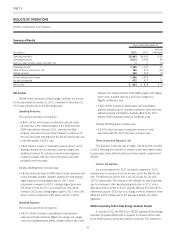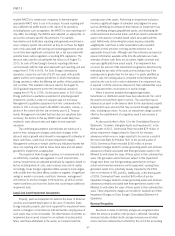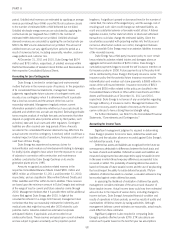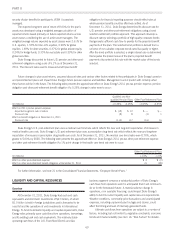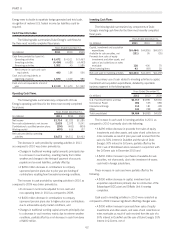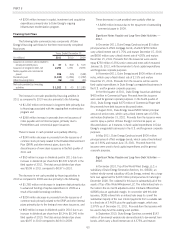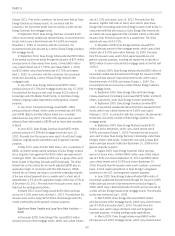Duke Energy 2011 Annual Report Download - page 76
Download and view the complete annual report
Please find page 76 of the 2011 Duke Energy annual report below. You can navigate through the pages in the report by either clicking on the pages listed below, or by using the keyword search tool below to find specific information within the annual report.
PART II
Vermont. As of the acquisition date, Duke Energy allocates goodwill
to a reporting unit, which Duke Energy defines as an operating
segment or one level below an operating segment.
Duke Energy recorded impairments of $500 million and $371
million related to Commercial Power’s non-regulated Midwest
generation reporting unit in 2010 and 2009. Subsequent to the
2010 impairment charges, there is no recorded amount of goodwill
at Commercial Power’s non-regulated Midwest generation reporting
unit. These impairment charges are recorded in Goodwill and Other
Impairment Charges on Duke Energy’s Consolidated Statement of
Operations. See Note 12 to the Consolidated Financial Statements,
“Goodwill, Intangible Assets and Impairments” for further information
regarding the factors impacting the valuation of Commercial Power’s
non-regulated generation reporting unit. Duke Energy determined that
no other goodwill impairments existed in 2011, 2010 and 2009.
As discussed in Note 12 to the Consolidated Financial
Statements, “Goodwill, Intangible Assets and Impairments”, Duke
Energy is required to test goodwill for impairment at the reporting unit
level at least annually and more frequently if events or circumstances
occur that would more likely than not reduce the fair value of a
reporting unit below its carrying value. Duke Energy evaluates the
carrying amount of its recorded goodwill for impairment on an annual
basis as of August 31 and performs interim impairment tests if a
triggering event occurs that indicates it is more likely than not that the
fair value of a reporting unit is less than its carrying value. The
analysis of the potential impairment of goodwill has historically
required a two step process. However, effective with the FASB’s
September 2011 issuance of new goodwill accounting guidance, an
entity may first assess qualitative factors to determine whether it is
necessary to perform the two step goodwill impairment test. Duke
Energy’s annual qualitative assessments under the new accounting
guidance include reviews of current forecasts compared to prior
forecasts, consideration of recent fair value calculations, if any, review
of Duke Energy’s, as well as its peers, stock price performance, credit
ratings of Duke Energy’s significant subsidiaries, updates to weighted
average cost of capital (WACC) calculations or review of the key
inputs to the WACC and consideration of overall economic factors,
recent regulatory commission actions and related regulatory climates,
and recent financial performance. If the results of qualitative
assessments indicate that the fair value of a reporting unit is more
likely than not less than the carrying value of the reporting unit, the
two-step impairment test is required.
In 2011, Duke Energy, after completion of its qualitative
assessments of the factors noted above, concluded that it was more
likely than not the fair value of each reporting unit exceeded its
carrying value. Thus, the two step goodwill impairment test was not
necessary in 2011.
For years in which the two step impairment test is necessary,
such as was the case in 2010 and 2009, step one of the
impairment test involves comparing the fair values of reporting units
with their carrying values, including goodwill. If the carrying amount
of a reporting unit exceeds the reporting unit’s fair value, step two
must be performed to determine the amount, if any, of the goodwill
impairment loss. If the carrying amount is less than fair value, further
testing of goodwill is not performed.
Step two of the goodwill impairment test involves comparing the
implied fair value of the reporting unit’s goodwill against the carrying
value of the goodwill. Under step two, determining the implied fair
value of goodwill requires the valuation of a reporting unit’s
identifiable tangible and intangible assets and liabilities as if the
reporting unit had been acquired in a business combination on the
testing date. The difference between the fair value of the entire
reporting unit as determined in step one and the net fair value of all
identifiable assets and liabilities represents the implied fair value of
goodwill. The goodwill impairment charge, if any, would be the
difference between the carrying amount of goodwill and the implied
fair value of goodwill upon the completion of step two.
For purposes of the step one analyses, determination of the
reporting units’ fair values is based on a combination of the income
approach, which estimates the fair value of Duke Energy’s reporting
units based on discounted future cash flows, and the market
approach, which estimates the fair value of Duke Energy’s reporting
units based on market comparables within the utility and energy
industries. Key assumptions used in the income approach analyses
for the U.S. Franchised Electric and Gas reporting units include, but
are not limited to, the use of an appropriate discount rate, estimated
future cash flows and estimated run rates of operation, maintenance,
and general and administrative costs, and expectations of returns on
equity in each regulated jurisdiction that will be achieved. In
estimating cash flows, Duke Energy incorporates expected growth
rates, regulatory stability and ability to renew contracts, as well as
other factors, into its revenue and expense forecasts.
Estimated future cash flows under the income approach are
based to a large extent on Duke Energy’s internal business plan, and
adjusted as appropriate for Duke Energy’s views of market participant
assumptions. Duke Energy’s internal business plan reflects
management’s assumptions related to customer usage and attrition
based on internal data and economic data obtained from third party
sources, projected commodity pricing data and potential changes in
environmental regulations. The business plan assumes the occurrence
of certain events in the future, such as the outcome of future rate filings,
future approved rates of returns on equity, anticipated earnings/returns
related to significant future capital investments, continued recovery of
cost of service and the renewal of certain contracts. Management also
makes assumptions regarding the run rate of operation, maintenance
and general and administrative costs based on the expected outcome of
the aforementioned events. Should the actual outcome of some or all of
these assumptions differ significantly from the current assumptions,
revisions to current cash flow assumptions could cause the fair value of
Duke Energy’s reporting units to be significantly different in future
periods.
One of the most significant assumptions that Duke Energy
utilizes in determining the fair value of its reporting units under the
income approach is the discount rate applied to the estimated future
cash flows. Management determines the appropriate discount rate for
each of its reporting units based on the WACC for each individual
reporting unit. The WACC takes into account both the pre-tax cost of
debt and cost of equity (a major component of the cost of equity is
the current risk-free rate on twenty year U.S. Treasury bonds). In the
2010 and 2009 step one impairment tests, Duke Energy considered
56



